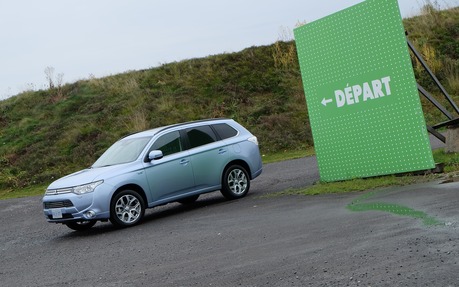Discovering The Mitsubishi Outlander PHEV
Mitsubishi is currently changing their brand image. While they may have been known among the younger crowd for building amazing Lancer Evolution rally machines that won multiple championships over the years, this type of publicity is not what gets people into showrooms anymore. Nowadays, customers are looking for fuel economy, electric vehicles and crossovers. So, Mitsubishi decided to hit multiple birds with one stone by offering us the Outlander PHEV, which is already sold in Europe. Since not all plug-in hybrid technology is born equal, the manufacturer invited The Car Guide to a demonstration of their electric Outlander.
Inspired by the i-MiEV
First of all, it’s important to remind everyone that this is not Mitsubishi’s first foray into the electric vehicle world. In fact, they are still selling the i-MiEV, and they have been perfecting it since 2009. But since they decided to build an electric crossover, the engineers needed more useable range, so they paired the i-MiEV’s drivetrain with a gasoline engine. And to give the Outlander PHEV a four-wheel drive drivetrain, they installed two electric motors (one for each set of wheels). The batteries (a 12 kWh unit) are placed under the vehicle’s floor, where the driveshaft would be on a regular Outlander, giving the PHEV as much interior space as the gasoline-powered version.
- Also: 2014 Mitsubishi Outlander: Conservative exterior, sophisticated mechanics
- Also: Mitsubishi Will Show Their Outlander PHEV Concept In Paris
There are four ways to fill said batteries: you can plug the vehicle into a 120 V (6 hours and 30 minutes for a full charge) or 240 V (charging then takes about 4 hours) wall socket, or use a 440 V recharge station which can fill the batteries back up to 80% of their charge in around 30 minutes. During regular driving, regenerative braking can also give you back a little juice. Finally, there is a small generator bolted to the 2 litre gasoline engine that sits under the hood. If the electric motors need more power than the batteries can give, the vehicle’s computer will start up the four-cylinder, which will in turn send power to the motors and the batteries.
Just like the Europeans
The Outlanders that we had the opportunity to try out were not pre-production vehicles. They came directly from Holland, where the vehicle is already sold (This plug-in Mitsubishi is actually quite popular in Europe: 33,000 units have been sold since it was launched in 2013). They were all top of the line InStyle Navi+ models (as the name implies, they had a navigation system, however it thought we were somewhere in France). We were told that the North American version of the plug-in crossover won’t look or feel anything like the one shown here (styling-wise, it will probably be closer to the Outlander PHEV Concept-S). However, the technology underneath it will be the same.
Under normal driving conditions, the vehicle accelerates using only electric power, and it’s easy to follow traffic without waking up the gasoline mill. According to the presentation, we can expect a 52 kilometre range on electric power alone. To send more power back to the batteries, the driver can use the steering wheel mounted paddles to increase or decrease regenerative braking when coasting. It is possible to drive at speeds of up to 120 km/h without using the four-cylinder engine. Over that speed, a clutch pack links it to the front wheels to give them more power. If the batteries are drained, the gasoline engine can directly power the vehicle, as long as it’s going over 64 km/h. Any slower than that, and the engine will revert to using its generator to power the vehicle, since it doesn’t have a transmission and would bog down in city driving.
Mitsubishi hopes to be the first manufacturer to offer an all-wheel drive electric crossover in North America when the Outlander PHEV arrives on our shores. Dealerships should start to receive them by the end of 2015 or early 2016, but expect the final production version to be unveiled before that.
